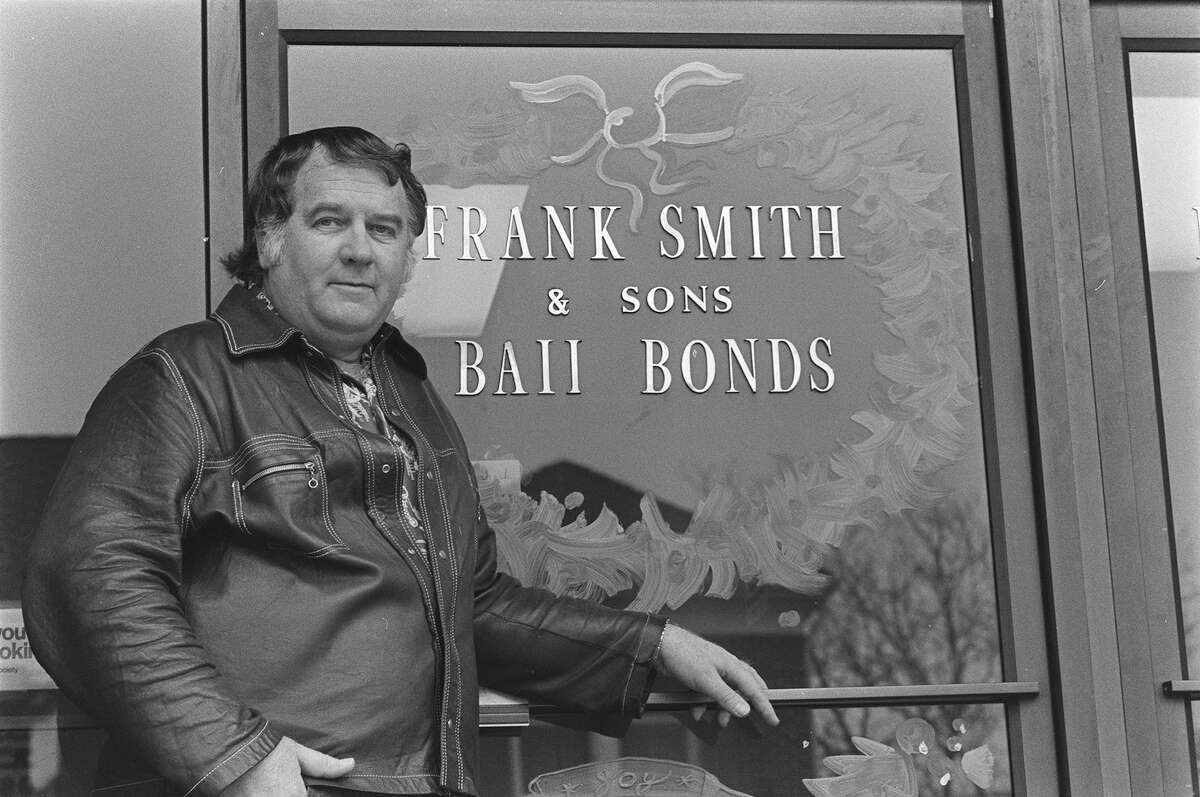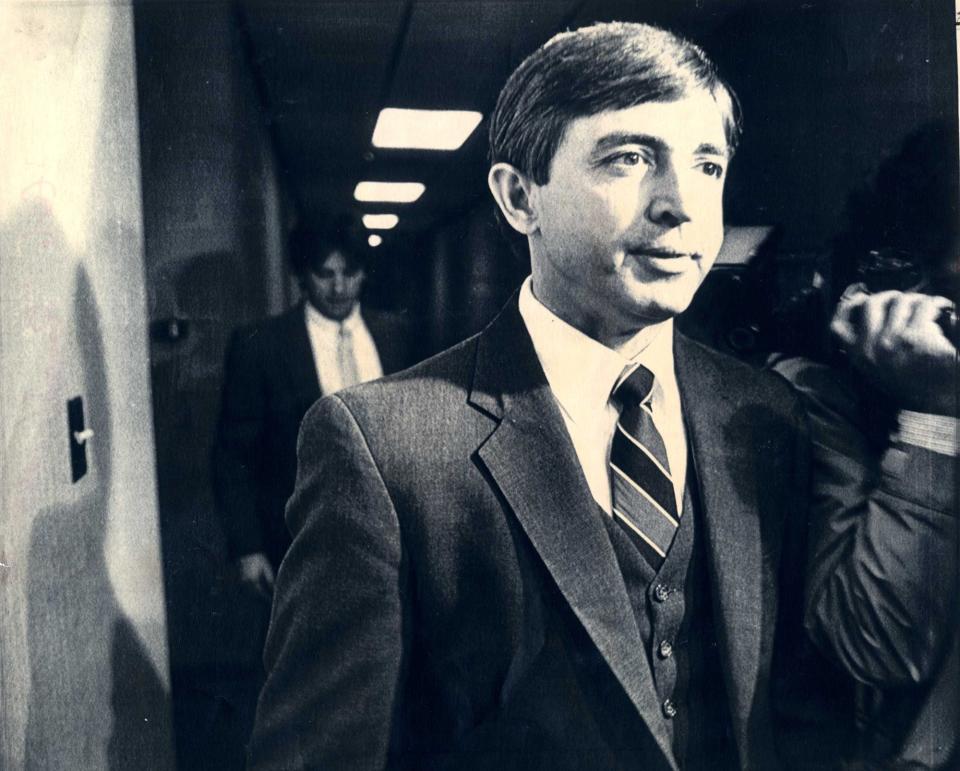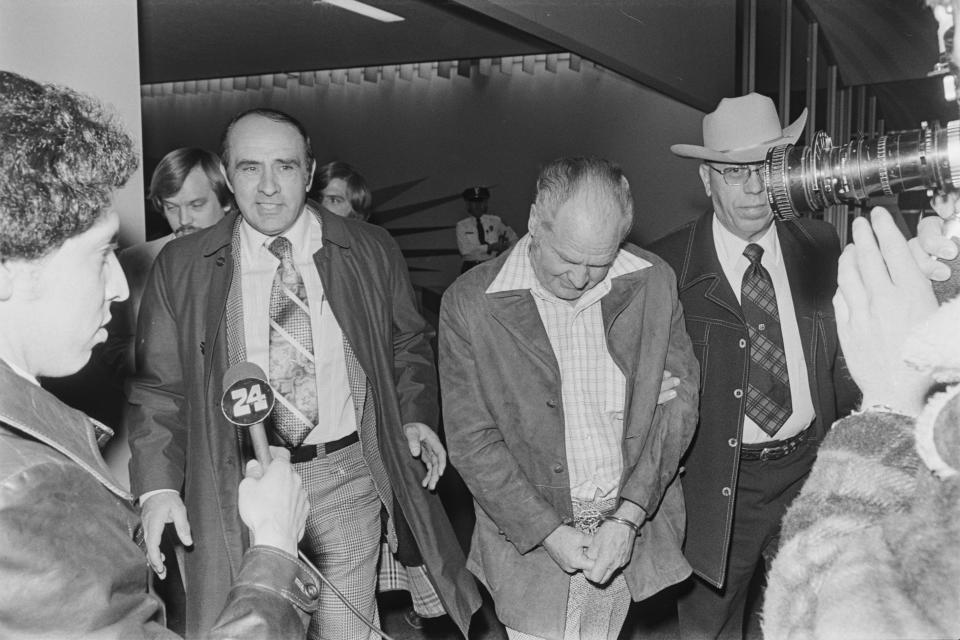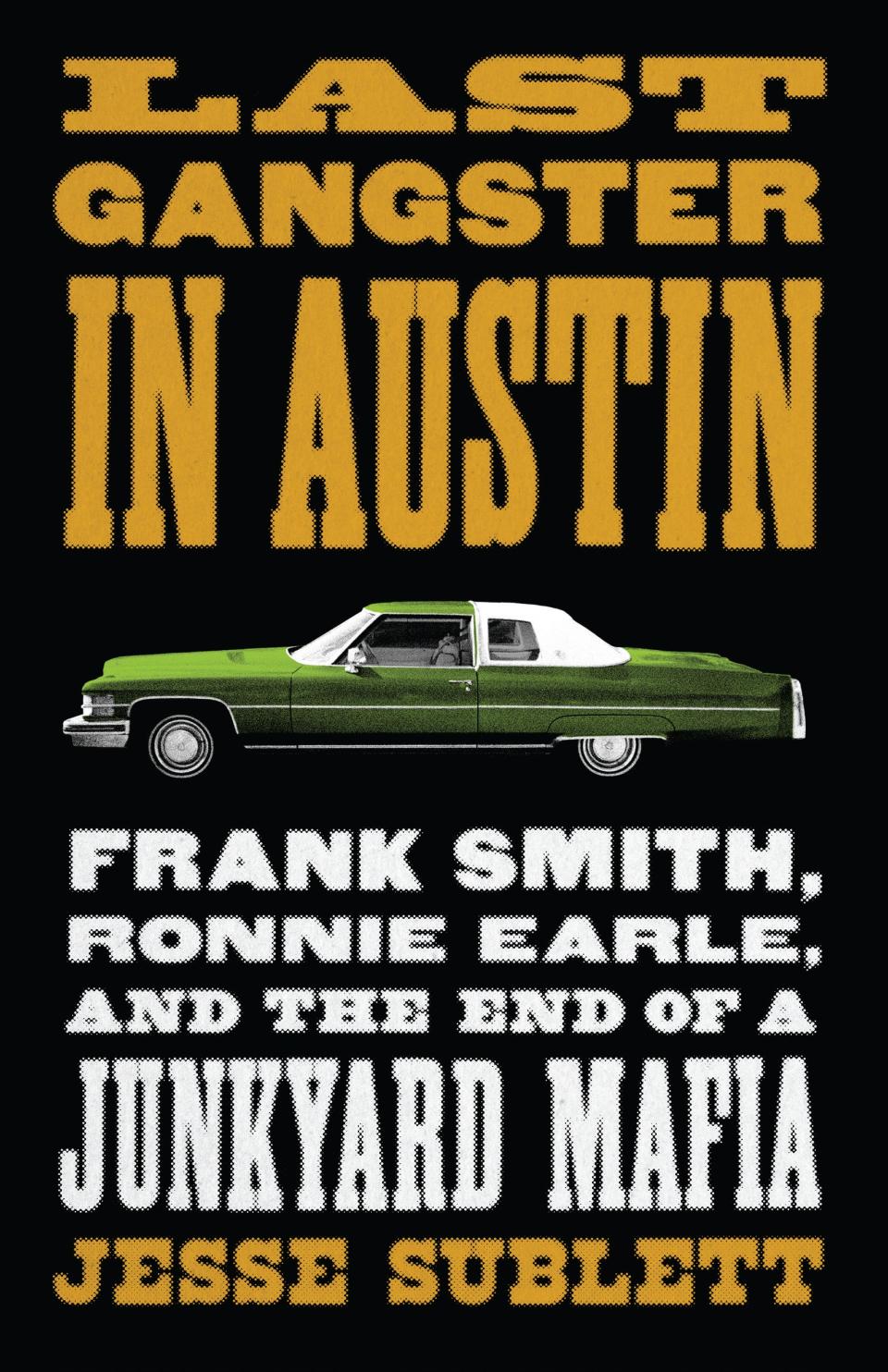This summer, snag a copy of 'Last Gangster in Austin,' a riveting book about 1970s Junkyard Mafia

- Oops!Something went wrong.Please try again later.
- Oops!Something went wrong.Please try again later.
If you pick up just one new Texas history this summer, make it "Last Gangster in Austin."
Author and musician Jesse Sublett's riveting true-crime story reads like a classic noir novel. It uncovers a seamy 1970s Texas underworld that you might not know existed, unless you have already read his equally revealing "1960s Austin Gangsters," published in 2015.
In that book, Sublett profiled the Overton Gang, which pulled off bank burglaries across the state, while they ran prostitution and smuggling rings. Timmy Overton of Austin and Jerry Ray James of Odessa, former football players, were sometimes allied, at other times at loggerheads with infamous Austin madam Hattie Valdes.
Elements of that gripping story overlap with Ken Roberts' tremendous "The Cedar Choppers: Life on the Edge of Nothing" (2018).
Although it also chronicles a criminal empire that fanned out to the rest of Texas, "Last Gangster in Austin: Frank Smith, Ronnie Earle and the End of the Junkyard Mafia" is more tightly focused and produced. Not a comma is out of place.
If this story is not made into a feature film — not just TV true-crime fodder — that in itself would be a crime.
His cast of characters is priceless.
At the center is Frank Smith, son of a Baptist preacher in Waco. A thrice-convicted felon, he operated the largest auto salvage yard in Austin and was also the most prominent bail bondsman.
"Through his connections with the criminal underworld and corrupt officials, he became very powerful and rich," Sublett says.

He was prosecuted by Ronnie Earle, who grew up on a ranch outside Fort Worth but came of age in Austin in the 1960s, a dynamic reformer who was enormously popular.
"The D.A.'s job, he believed, was not to put people in jail, but to see that justice was done," Sublett says. "His integrity was unassailable. Around the courthouse, they said, 'The only thing crooked about Ronnie is his teeth.'
"Like a lot of people my age in Austin in the 1970s, I knew this about Ronnie: He kind of looked like us — he had longish hair — he spearheaded efforts at reforming Texas’ draconian marijuana laws, and early in the Watergate scandal, he had called on Nixon to resign."
More: Texas expert shares tips on preserving your family's personal papers and photos
The primary victim, Ike Rabb, was the owner of Austin Salvage Pool. He had moved to Austin from Houston with his wife and six children so that his eldest daughter could attend the Texas School for the Deaf.
"Modest, hard-working, fun-loving and erudite," Sublett says, "Rabb stood firm against every one of Smith’s attempts to control, ruin or destroy him."
A fourth character, the Travis County sheriff, is harder to pin down.
"Raymond Frank never made sense to me," Sublett says. "He campaigned as a reformer, a friend of skinny dippers and pot smokers, a jogger in tennis shoes."
Yet Frank's actions, especially during the very public cases made against crime boss Smith, were criticized by the D.A., a federal grand jury and the FBI.
Currently, Sublett is taking a sabbatical of sorts in Los Angeles, where he has lived before. We chatted long-distance.
American-Statesman: The two major crimes, of many — an arson and an armed robbery — take place at a salvage yard. They make for good copy. Please describe them briefly.
Jesse Sublett: In the month of October 1976 alone, Smith attempted arson, intimidation and lawsuits to ruin Rabb’s business. On Oct. 18, 1976, Smith sent three men to burn down the Austin Salvage Pool. The men were spreading diesel fuel around the property when they accidentally touched off a butane tank that exploded and destroyed the mobile home the Rabbs used as an office.
Fearing capture, the arsonists departed, leaving the job less than half done. Smith had promised $1,500 for a job well done, but they settled for $600. One of Smith’s quirks as a criminal mastermind was that he paid such underlings by check — a habit that would come back to bite him.
Next, on Friday, Dec. 3, 1976, Smith drove to Austin Salvage Pool and paid Rabb and his wife, Jane, $15,000 cash for 50 wrecks. Minutes after he drove away, three armed, masked thugs descended on the chicken coop office.
Bullets flew, one robber fell dead from a double-barrel shotgun blast fired by quick-thinking Ike Rabb. The other two robbers fled, but were later captured. One of them, “Red” Holt, confessed that Smith had hired them for the job.

Frank Smith marshaled a small army of Texas lowlifes and criminals, including some from the unlikely crime hub of Haltom City outside of Fort Worth. How did he recruit them?
Smith apparently began building a network of criminal connections, both low and high, as a youth in Waco, among the convicts he served with in prison, and later, as a bail bondsman. An impressive number of career criminals from Haltom City turned out to be involved in this story, but I never found an origin story for that relationship. I was very curious, though, since it felt so ironic that Ronnie Earle, growing up in Birdville, was in close proximity to all that.
More: Our Think, Texas road trip to Corpus Christi just got bigger. Too big for one visit.
Using multiple sources, you make Frank Smith into an irresistibly likable character, while a cruelly viscous crime boss. How do you reconcile those characteristics?
Writing about criminals, I try to avoid being judgmental or moralistic. Frank did terrible things, but he wasn’t always a terrible human being. People got caught up in the wild vortex he created around himself, his self-absorbed ongoing oratory, deeds of generosity and efforts at humor spiced with cruelty or tragedy, and it all stemmed from this overwhelming need for attention and disruption, not unlike a certain polarizing political figure we know.
You’ve written elegantly before in the noir form. “Last Gangster in Austin” reads like tightly disciplined noir true crime report. Was that your intention?
Like all crime stories, it starts with disruption. You try to make sense of it. What happened?
I mean, it starts with a robbery at a junkyard. A would-be robber wearing a rubber monkey mask opens fire, misses everybody, dies of a shotgun blast. He left his prescription glasses in the getaway car.
What? A junkyard? Why? Who was that guy in the green Cadillac?
It’s like jazz. A melody, then a deconstruction, going inside and out each riff, each note, you put it all together. To me, that’s noir, and this story seemed to be the perfect noir thing.
All the old courthouse hands underestimated liberal newcomer Ronnie Earle. What were his strengths and weaknesses on this, his first big case?
Ronnie Earle had great knowledge of the law, but he had never tried a case in a courtroom. Earle and Smith had already jousted with each other by proxy when Earle was in the legislature, working on bail bond reform.
Once in office, Earle moved quickly to use the powers of his office to shut down Smith’s bail bond business and see that he was held without bail before the trial. Earle did a masterful job of crafting a case against Smith that depended heavily on testimony from Smith’s former underlings and achieved a successful outcome: a guilty verdict of life in prison and justice for the Rabb family.
In your previous book on the Overton Gang, you’ve brought to light an Austin — and Texas — underworld about which I knew nothing. What put you on this path?
I started out wanting to write like Dashiell Hammett and Raymond Chandler, so I wrote detective stories and novels set in Austin. I started writing about Austin in the 1970s with my memoir, "Never the Same Again." Much of that was about the murder of my girlfriend, Dianne Roberts, by a serial killer in 1976.
In my research I stumbled across these incredible stories about a junkyard mafia, an assassination in a downtown massage parlor, and the Timmy Overton Gang, led by ex-football players. If not for Austin crime in the 1960s and 1970s, I never would have written (books) about the Armadillo World Headquarters, Esther’s Follies and other stuff.
Your account of Frank Smith’s trial in Fredericksburg is a page-turner, even if we can reasonably guess the outcome. How did you piece it together?
The Rabb family had a copy of the trial transcripts, but a flood destroyed all but a single volume. Fortunately, that volume included some of the trial’s most important testimony, including when Frank testified and lead prosecutor Phil Nelson did a masterful job of taking him completely apart.

To make up for the other parts of the trial, I cobbled together material from the daily newspaper coverage. I also found the reporter’s notes for Frank’s bail hearing, in which the two thugs who had agreed to testify against him told their story in delicious detail.
In short, the trial is a patchwork of sources, but I think it all came together nicely.
I agree. You close your book with an appreciation of Ronnie Earle’s long, community-building career as D.A. I have to admit that he was just part of the permanent scenery when I arrived in 1984. I didn’t realize all the ways he made Travis County a better place. What were his biggest accomplishments?
Earle created the nation’s first Public Integrity Unit, which among other things, prosecuted cases of insurance fraud, Medicaid fraud, motor fuel tax evasion and other offenses that brought in millions of dollars in fines to the state treasury.
Earle was most passionate, however, about the effort he put into helping create entities and programs that promoted community welfare and social justice, such as the Children’s Advocacy Center, organized to provide better support for child abuse victims and more convictions in child abuse cases.
Earle also created the first Victim/Witness Assistance Division in Texas. Ideas developed during meetings of the Travis County Community Justice Council, which Earle also created and chaired, were adapted for inclusion in the 1989 Criminal Corrections Reform Act, for the most sweeping reforms to criminal justice in Texas in 50 years.
Although Earle liked to say that the Frank Smith trial was his “finest moment,” I believe he was proudest of his efforts in community justice reform, programs that addressed child abuse, served crime victims and helped “reweave the fabric of the community.”

Ronnie Earle, by the way, was district attorney when the killer of my girlfriend in 1976 was sentenced to two life terms. He’s still in jail. I guess I’ve always felt that Ronnie and I were connected in some way because of that, too.
So an insider question: How the heck did you gain access to all the major players, including American-Statesman reporter and later Gov. Ann Richards spokesman Bill Cryer, as well as the surviving relatives of Smith, Earle and others?
My book, "1960s Austin Gangsters," grew out of research I’ve been pursuing since the early 2000s, and along the way, I kept collecting stories as well as contacts.
Tressa Granger, daughter of Ned Granger, who was county attorney during the Frank Smith era, urged me to write about Frank for years. Tressa introduced me to Frank’s daughter, Letisha Taylor, and other important figures.
An old college friend grew up with Dottie Ross, who ran Frank’s bail bond office, another resource.
Texas history, delivered to your inbox
Click to sign up for Think, Texas, a newsletter delivered every Tuesday
A writer friend gave me Bill Cryer’s number. A few minutes into our first phone interview, we were like old pals. A whole lot of this book draws directly from the great writing that Bill did for the Statesman, and that also goes for a handful of other reporters I quote in the book.
I’ve had Ronnie Earle’s phone number for many years. When I was ready to start the book, I called the number. Twila answered. It was a little awkward, as Ronnie was days away from dying, but it turned out to be one of the most important calls I’ve ever made as a writer. Twila Earle is an impressive human being.
If not for her input, I don’t think you’d be reading this book.
Michael Barnes writes about the people, places, culture and history of Austin and Texas. He can be reached a mbarnes@statesman.com.
This article originally appeared on Austin American-Statesman: Snag 'Last Gangster in Austin,' a riveting book about 1970s Junkyard Mafia

